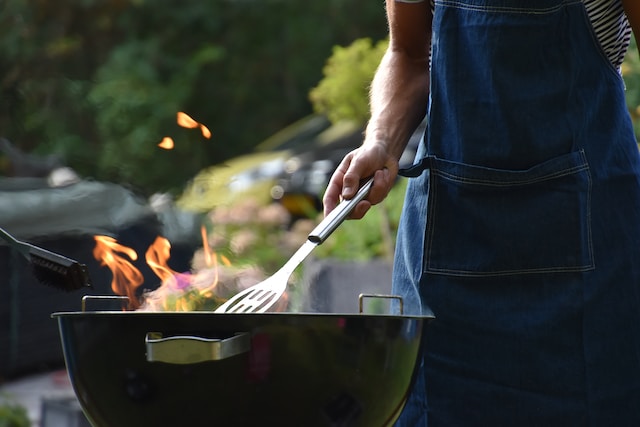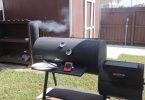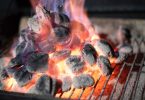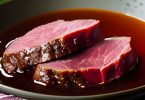Grilling and roasting are two popular cooking methods that are often used interchangeably, but they are actually quite different. While both methods involve cooking food with dry heat, the way in which the heat is applied can have a significant impact on the final result. Understanding the differences between grilling and roasting can help you choose the best method for your specific cooking needs.
Definition of Grilling and Roasting
Grilling involves cooking food on a metal grate over an open flame or direct heat source. This method is typically used for quick-cooking foods, such as steaks, hamburgers, and vegetables.
Grilling can result in a charred, smoky flavor and a crispy exterior, making it a popular choice for outdoor cooking and summer barbecues.
Roasting, on the other hand, involves cooking food in an oven or over a diffused heat source. This method is typically used for slower-cooking foods, such as roasts, whole chickens, and vegetables.
Roasting can result in a tender, juicy interior and a crispy exterior, making it a popular choice for holiday meals and special occasions. Understanding the differences between grilling and roasting can help you choose the best method for your specific cooking needs.
Comparison of Grilling and Roasting
Flavor
One of the biggest differences between grilling and roasting is the flavor of the food. Grilling gives food a smoky flavor that’s hard to replicate with any other cooking method.
The high heat from the flames or coals creates a charred exterior on the food, giving it a distinctive taste. This is especially true for meat and poultry, which develop a crispy exterior and a juicy interior.
Roasting, on the other hand, doesn’t impart a smoky flavor to the food. Instead, roasting allows the natural flavors of the food to shine through.
This is because the food is cooked at a lower temperature and for a longer time, allowing the flavors to meld together. Roasting is ideal for vegetables, which can develop a caramelized exterior and a tender interior.
Cooking Time
Grilling is a quick cooking method that’s ideal for foods that cook quickly, such as burgers, steaks, and fish. The high heat from the flames or coals cooks the food in a matter of minutes, giving it a crispy exterior and a juicy interior.
Roasting, on the other hand, is a slow cooking method that’s ideal for foods that require longer cooking times, such as roasts, whole chickens, and vegetables.
The food is typically cooked at a lower temperature and for a longer time, allowing it to cook evenly and develop a tender interior.
Cooking Temperature
Grilling requires high heat, typically around 450-550°F, to cook the food properly. This high heat is necessary to sear the exterior of the food and give it a crispy texture. The food is typically cooked directly over the flames or coals, which can be challenging to control.
Roasting, on the other hand, requires a lower temperature, typically around 325-375°F, to cook the food properly. This lower temperature allows the food to cook evenly and develop a tender texture. The temperature is usually set in the oven or the cooking vessel, which makes it easier to control.
Versatility
Grilling is a versatile cooking method that’s ideal for a variety of foods, including meat, poultry, fish, and vegetables. Grilling can also be used for different cooking techniques, such as direct grilling, indirect grilling, and smoking.
Roasting, on the other hand, is a versatile cooking method that’s ideal for a variety of foods, including meat, poultry, fish, and vegetables.
Roasting can also be used for different cooking techniques, such as dry roasting, wet roasting, and braising. Roasting can be done in an oven, on a stovetop, or on a grill, making it a flexible cooking method that can be adapted to different cooking environments.
Health Benefits
Grilling and roasting both have health benefits, but they can also have potential drawbacks. Grilling can be a healthier cooking method than frying, as it allows excess fat to drip away from the food.
However, grilling at high temperatures can produce carcinogenic compounds that are linked to cancer. To minimize the risk, it’s best to marinate the food before grilling, avoid charring the food, and cook it at lower temperatures.
Roasting can be a healthy cooking method, as it allows the food to cook in its own juices without the need for added fat. However, roasting can also lead to the loss of some nutrients in the food, particularly if it’s cooked at high temperatures for a long time. To minimize nutrient loss, it’s best to cook the food at lower temperatures for a shorter time and to use a covered cooking vessel.
Grilling: Direct Heat Cooking
Grilling is a popular cooking method that involves cooking food over an open flame or hot coals. It’s a great way to cook food quickly and impart a smoky flavor.
Grilling is ideal for foods that are small, flat, or thin, such as burgers, steaks, chicken breasts, and vegetables. In this section, we’ll cover the equipment needed for grilling, the cooking methods used in grilling, and some popular foods to grill.
Equipment for Grilling
The most important piece of equipment for grilling is, of course, the grill. There are many different types of grills available, including charcoal, gas, electric, and pellet grills.
Charcoal grills are the most traditional and give the food a smoky flavor, while gas grills are more convenient and allow for precise temperature control. Electric grills are ideal for small spaces and indoor use, while pellet grills use wood pellets to create a smoky flavor and are easy to use.
In addition to the grill, you’ll also need grilling tools such as tongs, spatulas, and a meat thermometer to ensure that your food is cooked to the correct temperature.
Some optional accessories include a grill brush for cleaning the grates, a drip pan for catching excess fat, and a smoker box for adding wood chips to enhance the smoky flavor.
Cooking Methods for Grilling
There are two main cooking methods used in grilling: direct heat and indirect heat. Direct heat cooking involves cooking the food directly over the flame or coals, while indirect heat cooking involves cooking the food away from the flame or coals, with the lid closed.
Direct heat cooking is ideal for small, thin, or flat foods that cook quickly, while indirect heat cooking is ideal for larger or thicker foods that require a longer cooking time.
Another important aspect of grilling is controlling the temperature. For direct heat cooking, it’s best to preheat the grill to a high temperature (around 400-450 degrees Fahrenheit) and then lower the heat to medium or low for cooking.
For indirect heat cooking, it’s best to preheat the grill to a lower temperature (around 300-350 degrees Fahrenheit) and then place the food away from the flame or coals to cook with the lid closed.
What to Grill on a Grill
There are many foods that are perfect for grilling, including:
- Burgers: The classic grilling food, burgers cook quickly and can be customized with a variety of toppings.
- Steaks: A high-quality steak cooked on a grill is hard to beat, with a seared crust and juicy interior.
- Chicken breasts: Chicken breasts are a lean protein that can be marinated or seasoned to add flavor.
- Vegetables: Grilling vegetables like peppers, onions, and zucchini can add a smoky flavor and char to their natural sweetness.
- Seafood: Fish, shrimp, and other seafood can be grilled for a delicate smoky flavor.
Roasting: Dry Heat Cooking
Roasting is another popular cooking method that involves cooking food in an oven with dry heat. This method is ideal for larger or thicker foods, such as whole chickens, roasts, and vegetables.
Roasting is a great way to cook food evenly and develop a crispy exterior while keeping the inside tender and juicy. In this section, we’ll cover the equipment needed for roasting, the cooking methods used in roasting, and some popular foods to roast.
Equipment for Roasting
The most important piece of equipment for roasting is an oven. Most ovens have a bake setting that allows for dry heat cooking. Convection ovens are ideal for roasting because they have a fan that circulates the hot air, cooking the food more evenly.
In addition to the oven, you’ll need a roasting pan or baking sheet to hold the food, a meat thermometer to ensure that the food is cooked to the correct temperature, and a basting brush to add flavor and moisture.
Cooking Methods for Roasting
There are two main cooking methods used in roasting: high-heat and low-heat. High-heat roasting involves cooking the food at a higher temperature (around 425-450 degrees Fahrenheit) for a shorter amount of time, while low-heat roasting involves cooking the food at a lower temperature (around 275-325 degrees Fahrenheit) for a longer amount of time.
When roasting, it’s important to keep the food moist and add flavor. This can be done by basting the food with melted butter, olive oil, or a marinade. You can also add aromatics like garlic, onions, or herbs to the roasting pan to infuse the food with flavor.
What to Roast in an Oven
There are many foods that are perfect for roasting in an oven, including:
- Whole chickens: Roasting a whole chicken in the oven is a classic dish that’s perfect for feeding a crowd.
- Roasts: Beef, pork, and lamb roasts can be seasoned with herbs and spices and roasted in the oven for a delicious and impressive meal.
- Vegetables: Roasting vegetables like potatoes, carrots, and Brussels sprouts can bring out their natural sweetness and add a crispy texture.
- Fish: Whole fish or fillets can be roasted in the oven with herbs, lemon, and butter for a healthy and flavorful meal.
Grilling and Roasting: Temperature and Heat
When it comes to cooking, understanding temperature and heat is key to getting the best results. Both grilling and roasting use heat to cook food, but the way in which they do so is different.
In this section, we’ll cover the different types of heat used in grilling and roasting, and how they affect the food being cooked.
Direct Heat for Grilling
Grilling uses direct heat, which means the food is cooked directly over the heat source. This type of heat is ideal for smaller and thinner foods that cook quickly, like burgers, steaks, and vegetables.
Direct heat can be adjusted by moving the food closer or farther away from the heat source. The higher the heat, the faster the food will cook, but it can also increase the risk of burning.
Indirect Heat for Grilling
Indirect heat is another grilling method that involves cooking the food next to the heat source, rather than directly over it. This type of heat is ideal for larger or thicker foods that require longer cooking times, like whole chickens or roasts.
Indirect heat is achieved by turning off one or more burners on a gas grill, or by pushing the coals to one side of a charcoal grill. The food is then placed on the cooler side of the grill and cooked with the lid closed. This allows the food to cook evenly without the risk of burning.
Dry Heat for Roasting
Roasting uses dry heat, which means the food is cooked in a dry environment, like an oven. This type of heat is ideal for larger or thicker foods that need to be cooked through, like roasts or whole chickens.
Dry heat cooks food by surrounding it with hot air, which causes the food to brown and develop a crispy exterior. However, it can also dry out the food if not monitored closely.
Diffused Heat for Roasting
Diffused heat is another roasting method that involves placing the food on a rack in the roasting pan, which allows hot air to circulate around the food. This type of heat is ideal for foods that need to be cooked evenly, like vegetables or fish.
Diffused heat can be achieved by placing a rack in the roasting pan, which elevates the food above the bottom of the pan, allowing hot air to circulate around the food.
By understanding the different types of heat used in grilling and roasting, you can choose the best method for the food you’re cooking.
Direct heat is great for smaller and thinner foods that cook quickly, while indirect heat is ideal for larger or thicker foods that require longer cooking times.
Dry heat is perfect for larger or thicker foods that need to be cooked through, while diffused heat is great for foods that need to be cooked evenly. With a little practice and experimentation, you can become a master at using heat to cook delicious meals.
Pros of Grilling
Grilling is a favorite cooking method for many people, and it has several benefits. Firstly, grilling is a quick and easy way to cook food. The direct heat from the grill cooks the food quickly, which is perfect for those who are short on time.
Secondly, grilling is a healthier cooking method compared to other methods like frying because it doesn’t require adding any oil or fat. This makes it a great option for those who are watching their calorie intake.
Another great benefit of grilling is that it gives food a unique smoky flavor that’s hard to replicate with other cooking methods. The smoky flavor is imparted to the food due to the burning of the charcoal or wood used to fuel the grill.
Grilling is also a versatile cooking method that can be used to cook a variety of dishes, including meat, vegetables, and fruits.
Cons of Grilling
While grilling has several benefits, there are some downsides to this cooking method as well. Firstly, grilling can be messy, and it requires a bit of cleaning up afterward.
Secondly, grilling can be a bit tricky to get right. The heat needs to be just right, and the food needs to be watched carefully to avoid burning or undercooking.
Lastly, grilling can be affected by the weather. Rain, wind, and extreme temperatures can make it difficult to grill outside.
Pros of Roasting
Roasting is a dry-heat cooking method that’s commonly used in baking and cooking. It’s a great way to cook larger cuts of meat, such as beef or pork roasts, and it produces food that is tender and flavorful.
One of the biggest advantages of roasting is that it’s an easy cooking method. Once the food is in the oven, you don’t need to watch it closely, allowing you to focus on other tasks.
Roasting is also a healthy cooking method because it doesn’t require the use of any added fats or oils. The dry heat cooks the food while retaining its natural flavor and nutrients. Lastly, roasting is a versatile cooking method that can be used to cook a wide range of dishes, including vegetables, potatoes, and meats.
Cons of Roasting
While roasting has several benefits, it also has some drawbacks. Firstly, roasting takes longer than grilling, making it less suitable for those who are short on time.
Secondly, roasting requires the use of an oven, which can be expensive to run and can heat up the house during the warmer months. Lastly, roasting can dry out the food if it’s not cooked properly, making it less flavorful and less enjoyable to eat.
Conclusion
Grilling and roasting are two popular cooking methods that have their own unique advantages and disadvantages. Grilling is ideal for quick-cooking foods that require high heat, while roasting is ideal for slow-cooking foods that require a lower temperature.
Both methods can be adapted to different cooking environments and can be used for a variety of foods, including meat, poultry, fish, and vegetables.
Ultimately, the choice between grilling and roasting will depend on your personal preference, the type of food you’re cooking, and the cooking environment you have available.
By understanding the differences between these two cooking methods, you can choose the one that’s best for your cooking needs and create delicious, healthy meals that your family and friends will love.







